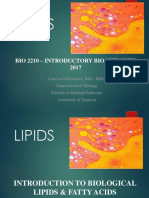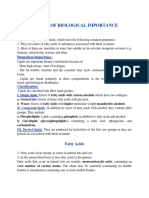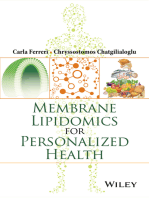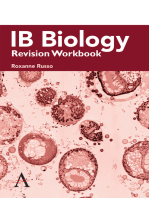Lipid
Lipid
Uploaded by
Faridah Yuwono 28Copyright:
Available Formats
Lipid
Lipid
Uploaded by
Faridah Yuwono 28Original Description:
Copyright
Available Formats
Share this document
Did you find this document useful?
Is this content inappropriate?
Copyright:
Available Formats
Lipid
Lipid
Uploaded by
Faridah Yuwono 28Copyright:
Available Formats
Lecture 2 : Lipids
Lipids are compounds, present in
plants and animals, that are soluble in
non polar solvent, such as chloroform
or eter, but not soluble in water.
2
3
Five (5) types of lipids:
Energy-storage lipids: triacylglycerols
Membrane lipids: phospholipids
Emulsification lipids: bile
Messenger lipids: steroid hormones
Protective lipids: biological waxes
4
FATTY ACIDS:
Saturated
Unsaturated
GLYCERIDES:
Neutral
Phosphoglycerides
COMPLEX LIPID:
Lipoproteins
Glycolipids
NONGLYCERIDES:
Sphingolipids
Steroid
Waxes
5
Fatty acids: a component of
many lipids
Different types of fatty acids:
Saturated fatty acid
Biosynthesized fatty acids are further classified as:
Long-chain: contain 12-26 carbons
Medium-chain: contain 6-10 carbons
Short-chain: contain 4-6 carbons
Unsaturated fatty acid
Monounsaturated fatty acid: exp (20:1).
Polyunsaturated fatty acids (PUFA): exp (20:3).
Monocarboxylic acids.
6
Physical properties
of fatty acids
the length and degree of
unsaturation.
Solubility in H
2
O
Chain Length
Melting Point
chain > > solubility < <
unsaturation > > melting point < < as due to
the lack of compact packing as a result of kinks
introduced by the double bonds
melting point > >
7
D.B.
0
1
2 3
4
melting
temperature
All unsaturated
fats are oils at room
temperature
16:0
60
16:1
1
18:0
63
18:1
16
18:2
-5
18:3
-11
20:0
75
F. A. M. P. (
0
C)
20:4
-50
1 D.B.
Cis D.B.
2 D.B.
8
Some fatty acids and their common names:
14:0 myristic acid; CH
3
(CH
2
)
12
-COOH
16:0 palmitic acid; CH
3
(CH
2
)
14
-COOH
18:0 stearic acid; CH
3
(CH
2
)
16
-COOH
18:1 cisD
9
oleic acid CH
3
(CH
2
)
7
CH=CH(CH
2
)
7
-COOH
Double bonds in fatty
acids usually have the
cis configuration.
Most naturally
occurring fatty acids
have an even number
of carbon atoms.
C
O
O
1
2
3
4
fatty acid with a cis-D
9
double bond
9
18:2 cisD
9,12
linoleic acid
CH
3
(CH
2
)
4
CH=CHCH
2
CH=CH(CH
2
)
7
-COOH
is used to synthesize arachidonic acid, which regulates blood
pressure, clotting et
18:3 cisD
9,12,15
a-linonenic acid
CH
3
CH
2
CH=CHCH
2
CH=CHCH
2
CH=CH(CH
2
)
7
-COOH
is used to synthesize eicosapentaenoic acid (EPA) and docosahexanoic acid
(DHA) which are required for normal brain function and development (an
omega-3)
20:4 cisD
5,8,11,14
arachidonic acid
20:5 cisD
5,8,11,14,17
eicosapentaenoic acid(an omega-3)
10
11
Waxes
12
ester of fatty acids and
O
C
30
H
61
O C C
15
H
31
O
C
16
H
33
O C C
15
H
31
Important in fruits:
1. Natural protective layer in fruits, vegetables, etc.
2. Added in some cases for appearance and protection.
Beeswax (myricyl palmitate),Spermaceti (cetyl palmitate)
O
||
R - C - O - R
1
Waxes :
long chain alcohol
13
C-OH
CH
C-OH
H
H
H
H
HO-
glycerol
Monoacylglycerol/monoglyceride
H-O-C-CH
2
C-R
1
O
Diacylglycerol/
diglyceride
R
2
-CH
2
-C-OH
O
H-O-C-CH
2
C-R
3
O
Triacylglycerol = Triglyceride
14
15
16
The chemical reactions of triacylglycerols are similar
to those of alkenes and esters.
Hydrogenation of double bonds in unsaturated fatty
acids by H
2
(compare to alkenes).
Chemical Properties of Triacylglycerols
Hydrolysis of ester bonds by water
in the presence of an acid, a base,
or an enzyme (compare to esters).
TAG :
* energy reservoirs * insulator
* digested in the small intestine by
the enzyme pancreatic lipase
* saponification : formation of soaps
Monoacylglycerols are absorbed through
the intestinal cells, re-converted to TG
and assembled into lipoproteins
17
Triglycerides
Stored as droplets of
adipose tissue in body
fat.
Fat stored in this cell
18
Hydrogenated Fats
Hydrogenation of
vegetable oils to
margarine or
shortening, not only
convert unsaturated
bond to saturated, but
also may converts some
of cis unsaturated
bonds to trans
configuration
Diet high in trans fatty
acids risks heart
disease, cancer.
cis trans
*
19
PYROLYSIS
Hydrogenation: addition of two hydrogen atoms
over a double bond. Some food products are
partially hydrogenated
O O
// //
CH
2
- O - C - R
1
3
CH
2
- O - C - R
O
//
CH - O - C - R
2
O
O //
// CH
2
= CH - C - H
CH
2
- O - C - R
3
D
fatty acids
acrolein
-o
2
20
- COOH
( fatty acid)
- C = C - + O
2
- C - C - - CHO
- C=O
O - O
(Peroxide)
H
2
O
Oxidation
Oxidation: addition of oxygen (derived from air),
lead to oxidize the double bonds present in a
fatty acid to produce carboxylic acid, and other
carbonyl compound (keton, aldehyd) through
peroxide intermediate.
21
Rancidification
O
//
Fat R - CH
2
- CH
2
- C - O - H
O O
// //
R - C - CH
2
- C - O - H R - C - C + CO
2
//
O Keton
Lipase
-Oksidase
+
the decomposition
of fats and other
lipids by
hydrolysis and or
oxidation
Keton or acids produced from lipid oxidation /rancidification
process have low-molecular-mass and volatile. This volatile
compounds are reponsible for rancid odor and flavor in some
food products. Antioxidant is usually added to prevent lipid
oxidation which lead to rancidity.
22
Glycerol esterified with 2
fatty acids.
Third position is
phosphate
Other end of phosphate
can combine with other
molecules to form various
derivatives
Amphipathic emulsifying
agents
component of cell
membrane
PHOSPHATE
O H
H
O H
H
H
O H H
O H
H
H
O H
Phosphatidyl
inositol
23
polar
non-polar
"kink" due to
double bond
O P O
O
O
H
2
C
CH
H
2
C
O C R
1
O O C
O
R
2
X
glycerophospholipid
a polar region:
glycerol, carbonyl O
of fatty acids, P
i
, & the
polar head group (X)
non-polar hydrocarbon tails
of fatty acids (R
1
, R
2
).
Each glycerophospholipid / phosphoacylglycerol
possess:
24
O P O
O
O
H
2
C
C H
H
2
C
O C R
1
O O C
O
R
2
H
H
Phosphatidic acid
Phosphatidyl
-
O H
H
O H
H
H
O H H
O H
H
H
O H
Phosphatidylinositol
Phosphatidylinositol has roles in cell signaling, as
well as component of cell membrane
C H
2
C H
2
N C H
3
C H
3
C H
3
+
Phosphatidylcholine/lechitin
It is a common membrane lipid
25
phosphatidyl choline = lechitin
Lecithin, a
common food
additive, is a
phospholipid,
Which
embedded in
cell
membranes.
26
Cell Membrane
27
Structure of Phosphatidyl choline with
2 fatty acids, oleate and palmitate
O
C H
3
N
+
CH
3
CH
3
O
(CH
2
)
14
CH
3
O
O
O
(CH
2
)
7
C
H
C
H
(CH
2
)
7
CH
3
CH
2
C H
C H
2
O P
O
O
28
Sphingolipids
Sphingosine instead of glycerol
Derivatization at ester C1
Fatty acids added at amine
Different types are found in
plasma membrane and myelin
sheaths
29
2
H
2
C
H
C
O H
C H
N C H
C
C H
2
C H
3
H
( )
1 2
sphingosine
Sphingolipids
/ceramide
H
O H
C
R
O
OH
The amino group of sphingosine can
form an amide bond with carboxylate
group of a fatty acid, to yield a
ceramide
Ceramides usually include a polar head
group, esterified to the terminal OH
of the sphingosine
P O O
O
H
2
C
H
2
C
N
+
C H
3
H
3
C
C H
3
OH
Sphingomyelin, a ceramide
with a phosphocholine or
phosphethanolamine head
group, is a common constituent
of plasma membranes
Sphingomyelin
Sphingomyelins
are found
abundantly in the
myelin sheath that
surrounds the
nerve fibers
P O O
O
H
2
C
H
2
C
N
+
C H
3
H
3
C
C H
3
O H
O
H
H
H
O H H
O H
C H
2
O H
H
A cerebroside is a
sphingolipid (ceramide) with a
monosaccharide such as
glucose or galactose as polar
head group.
30
Steroid Nucleus
Consists of:
3 cyclohexane rings.
1 cyclopentane ring.
no fatty acids.
steroid nucleus
31
CH
3
CH
3
CH
3
CH
3
HO
CH
3
Cholesterol
is the most abundant steroid in the body.
has methyl CH
3
- groups, alkyl chain, and -
OH attached to the steroid nucleus.
O H
32
Cholesterol:
-important constituent of cell
membranes
-has a rigid ring system and a
short branched hydrocarbon
tail.
O H
hydrophobic amphipathic.
Keeps the lipids in membrane
from aggregrating, eliminate of
excess cholesterol in intestinal
tract and artery.
- Precursor to Bile Acids:
- Crusial role in lipid
digestion
- break up large lipid to
smaller one, make it
can be broken easily
by enzymes
Precursor to steroid hormones that
regulate gene expression
Precursor to Vitamin D
A normal, open artery.
An artery clogged by
cholesterol plaque
33
Cholesterol inserts into bilayer membranes with its
hydroxyl group oriented toward the aqueous phase &
its hydrophobic ring system adjacent to fatty acid
chains of phospholipids.
O H
34
.
The OH group of cholesterol forms hydrogen bonds
with polar phospholipid head groups.
35
Lipoproteins: LDL, HDL, Etc
combine lipids
with proteins &
phospholipids.
are soluble in
water because its
surface consists of
polar lipids.
36
Types of Lipoproteins
differ in density, composition, and function.
include low-density lipoprotein (LDLs) and high-
density lipoprotein (HDLs).
37
Transport of Lipoproteins in the Body
38
LDL
circulate in the
blood
Build up in arteries;
lead to heart attack
HDL
level 130 mg/dL,
reflects an increased
risk of heart disease
level < 40 mg/dL, is
thought to increase the
risk for heart disease.
cholesterol lipoprotein,
that returns to the liver ;
removes cholesterol out of
the bloodstream;
believed to prevent heart
attacks
You might also like
- Pepsi Screening Edu 220 JohnsonDocument10 pagesPepsi Screening Edu 220 Johnsonapi-515125491No ratings yet
- Lipid For PresentationDocument30 pagesLipid For PresentationAsnan Azis FatoniNo ratings yet
- Complex Lipids & MembranesDocument57 pagesComplex Lipids & MembranesNabila PutriNo ratings yet
- Lipids Function and StructureDocument60 pagesLipids Function and StructureIndra GunawanNo ratings yet
- Lipids Function and StructureDocument58 pagesLipids Function and StructureTeddy K KunongNo ratings yet
- Chapter 3 Lipids PDFDocument55 pagesChapter 3 Lipids PDFVinz TombocNo ratings yet
- By: Drg. Prasetyo Adi, MSDocument50 pagesBy: Drg. Prasetyo Adi, MSrizal_31No ratings yet
- 3 LipidsDocument44 pages3 LipidsSuresh ChovatiyaNo ratings yet
- Lipids year 2024 (1)-1Document62 pagesLipids year 2024 (1)-1alimelhem9090No ratings yet
- Lipid UpdateDocument50 pagesLipid UpdateIlmi Dewi ANo ratings yet
- Lipid: Ahmad Rifai Siwi Shintara YulihartonoDocument78 pagesLipid: Ahmad Rifai Siwi Shintara YulihartonosiwishintaraNo ratings yet
- Dr. Drh. Trini Susmiati, MP. Department of Biochemistry Faculty of Veterinary Universitas Gadjah MadaDocument49 pagesDr. Drh. Trini Susmiati, MP. Department of Biochemistry Faculty of Veterinary Universitas Gadjah MadaNurul Sukmaning HabibieNo ratings yet
- BIOCHEM - LipidDocument323 pagesBIOCHEM - LipidPrincess Jeyan PagatpatanNo ratings yet
- Saturated Fatty Acids: Lec Notes - LipidsDocument10 pagesSaturated Fatty Acids: Lec Notes - LipidsJonah Micah MangacoNo ratings yet
- Lipids ClassificationDocument7 pagesLipids ClassificationAdamFerdianNo ratings yet
- LipidsDocument31 pagesLipidsJosephine AcioNo ratings yet
- Classification of LipidsDocument54 pagesClassification of Lipidskriti100% (1)
- 7 - Structur Lipid & As. Lemak TrisuspptDocument47 pages7 - Structur Lipid & As. Lemak TrisuspptNurul Sukmaning HabibieNo ratings yet
- Module 4 - LipidsDocument17 pagesModule 4 - Lipidsjanmariefernandez0No ratings yet
- Chapter 4 Lipids-1Document45 pagesChapter 4 Lipids-1sealilne21No ratings yet
- Components of Food: Chemistry Project 2005-2006Document69 pagesComponents of Food: Chemistry Project 2005-2006Ann Deocampo DuayNo ratings yet
- Lipids Classsification, Functns, Physical and Chm Ppties andDocument7 pagesLipids Classsification, Functns, Physical and Chm Ppties andcodymike24434No ratings yet
- Unit 8 WebDocument86 pagesUnit 8 WebIris Dinah BacaramanNo ratings yet
- Chemistry of Lipids 21Document140 pagesChemistry of Lipids 21gauravjangir1020No ratings yet
- LipidsDocument154 pagesLipidsMahnoor KhalilNo ratings yet
- Chem Nature of Lipids 2022Document43 pagesChem Nature of Lipids 2022Amina Nadeem100% (2)
- Lipid Metabolism 1 2018Document44 pagesLipid Metabolism 1 2018jeozbapqfpugltpsrbNo ratings yet
- Lipid: Sylvia Rianissa PutriDocument60 pagesLipid: Sylvia Rianissa PutriBhayuBarunaNo ratings yet
- Lipids Revised 02-10-2021-1Document42 pagesLipids Revised 02-10-2021-1Niruta NepaliNo ratings yet
- L5 - Lipids and MembranesDocument28 pagesL5 - Lipids and Membraneshaiqalfariq07No ratings yet
- Chemical and Physical Properties of Oil and FatsDocument40 pagesChemical and Physical Properties of Oil and FatsAzrin RahmanNo ratings yet
- 3644 Unit 2 CarbohydrateDocument98 pages3644 Unit 2 Carbohydrateazeem dilawarNo ratings yet
- LipidDocument31 pagesLipidصالح مقالحNo ratings yet
- Lipids: Structure and ClassificationDocument83 pagesLipids: Structure and ClassificationGOT7 ł IGOT7 TRUSTNo ratings yet
- Chapter 2 Lipids 2024-2025-CorrectedDocument16 pagesChapter 2 Lipids 2024-2025-CorrectedMohamed dzNo ratings yet
- Lipids (Mcmurry Ch. 27)Document15 pagesLipids (Mcmurry Ch. 27)Meisy RadhistaNo ratings yet
- LIPIDSDocument87 pagesLIPIDSc4550288No ratings yet
- BIO2210 LipidsDocument83 pagesBIO2210 Lipidsantonio latenNo ratings yet
- 161020190Dr EmanDocument31 pages161020190Dr Emanslmen1269No ratings yet
- O.chem lipidsDocument27 pagesO.chem lipidspaulos asefaNo ratings yet
- LipidsDocument83 pagesLipidsJoana Marie Salinas-BeltranNo ratings yet
- (Dr. Edwin) Lipid BiochemistryDocument69 pages(Dr. Edwin) Lipid Biochemistryvbbvvh82No ratings yet
- Macro Molecules 1Document26 pagesMacro Molecules 1muhammadsohail3850No ratings yet
- Lec Notes LipidsDocument13 pagesLec Notes LipidsJonah Micah MangacoNo ratings yet
- Lipid Chemistery Hand Out FinalDocument12 pagesLipid Chemistery Hand Out FinalPIH SHTNo ratings yet
- Lipid Chemistery Hand Out FinalDocument12 pagesLipid Chemistery Hand Out FinalPIH SHTNo ratings yet
- 01 Structure of LipidsDocument56 pages01 Structure of LipidsOmamaNo ratings yet
- LipidDocument80 pagesLipidMirza Salman BaigNo ratings yet
- CHM 121 - LipidsDocument20 pagesCHM 121 - LipidsRaphaelNo ratings yet
- CarbohydratesDocument40 pagesCarbohydratesokemokenanNo ratings yet
- session 4 & 5Document5 pagessession 4 & 5maddulasrijaNo ratings yet
- (Organic Natural Products) General Introduction:: Carbohydrates GlucoseDocument16 pages(Organic Natural Products) General Introduction:: Carbohydrates GlucoseAkib AbidNo ratings yet
- Lipid Digestion and MetabolismDocument65 pagesLipid Digestion and MetabolismEricaNo ratings yet
- Lipid Digestion and AbsorptionDocument37 pagesLipid Digestion and AbsorptionIMDCBiochem100% (1)
- LecturerDocument105 pagesLectureratef.salman.grNo ratings yet
- 5.lipid Dan Asam LemakDocument29 pages5.lipid Dan Asam LemakLatoya BaileyNo ratings yet
- Lipids Function and StructureDocument60 pagesLipids Function and StructureDifa Kartika BakrieNo ratings yet
- Lecture 2 - Carbohydrate - TaggedDocument48 pagesLecture 2 - Carbohydrate - Taggedhashm.f.alamerNo ratings yet
- Fast Facts: Long-Chain Fatty Acid Oxidation Disorders: Understand, Identify and SupportFrom EverandFast Facts: Long-Chain Fatty Acid Oxidation Disorders: Understand, Identify and SupportNo ratings yet
- Sistem Informasi Dan Administrasi Pemasaran Pada PT - Kaltengpos Press Berbasis WebDocument13 pagesSistem Informasi Dan Administrasi Pemasaran Pada PT - Kaltengpos Press Berbasis WebFaridah Yuwono 28No ratings yet
- Lecture 3 DNA RNA Gen Structure Ade FKUI 2012Document44 pagesLecture 3 DNA RNA Gen Structure Ade FKUI 2012Faridah Yuwono 28No ratings yet
- SPECIAL SENSES HearequismltasteDocument22 pagesSPECIAL SENSES HearequismltasteFaridah Yuwono 28No ratings yet
- Gene Transcription 1Document18 pagesGene Transcription 1Faridah Yuwono 28No ratings yet
- Human Reproductive System and Human Development: Deswaty FurqonitaDocument33 pagesHuman Reproductive System and Human Development: Deswaty FurqonitaFaridah Yuwono 28No ratings yet
- Fertility Disorder On Male - SILVIADocument39 pagesFertility Disorder On Male - SILVIAFaridah Yuwono 28No ratings yet
- Cardiovasc.-Nutr Therapy - Univ PlkrayaDocument67 pagesCardiovasc.-Nutr Therapy - Univ PlkrayaFaridah Yuwono 28No ratings yet
- Drugs Used in Gastrointestinal Diseases FinalDocument30 pagesDrugs Used in Gastrointestinal Diseases FinalFaridah Yuwono 28No ratings yet
- Antiangina and Hipolipidemic AgentsDocument83 pagesAntiangina and Hipolipidemic AgentsFaridah Yuwono 28No ratings yet
- Community Medicine Department Faculty of Medicine University of Indonesia Setyawati Budiningsih, Retno Asti Werdhani Nuri Purwito Adi April 4th 2012Document60 pagesCommunity Medicine Department Faculty of Medicine University of Indonesia Setyawati Budiningsih, Retno Asti Werdhani Nuri Purwito Adi April 4th 2012Faridah Yuwono 28No ratings yet
- Quiz 2 REVISIONDocument8 pagesQuiz 2 REVISIONAma 926666No ratings yet
- Dora PosterDocument1 pageDora Postermanas chatterjeeNo ratings yet
- Functions of CarbohydratesDocument5 pagesFunctions of CarbohydratesJoe WakeNo ratings yet
- Kinder Endline 2019 2020 T.jen T. MarvinDocument17 pagesKinder Endline 2019 2020 T.jen T. MarvinJenRomarateCervantesNo ratings yet
- 20-Appendices PeriodicitySchedule Bright FuturesDocument1 page20-Appendices PeriodicitySchedule Bright FuturesdrjohnckimNo ratings yet
- SBFP Form 1: Master List Beneficiaries For School-Based Feeding Program (SBFP)Document28 pagesSBFP Form 1: Master List Beneficiaries For School-Based Feeding Program (SBFP)Reymart Tandang AdaNo ratings yet
- Peripheral Artery DiseaseDocument8 pagesPeripheral Artery DiseaseDrNadia ZubairNo ratings yet
- Body Comp & Diaph Mov - Normal Diaphragmatic Motion and The Effects of Body Composition Determination With M-Mode Sonography PDFDocument6 pagesBody Comp & Diaph Mov - Normal Diaphragmatic Motion and The Effects of Body Composition Determination With M-Mode Sonography PDFnirchennNo ratings yet
- Hindbrain Neurons As An Essential Hub in The Neuroanatomically Distributed Control of Energy BalanceDocument14 pagesHindbrain Neurons As An Essential Hub in The Neuroanatomically Distributed Control of Energy BalanceAnton PatriaNo ratings yet
- Healthy in A HurryDocument22 pagesHealthy in A HurryWeldon Owen Publishing100% (4)
- Morton BookDocument12 pagesMorton BookAllynoelNo ratings yet
- Ed Coan WriteupDocument11 pagesEd Coan Writeupcelltech111No ratings yet
- Nutrisi Untuk JantungDocument647 pagesNutrisi Untuk JantungPramanda Putra100% (1)
- NCP Diabetes Mellitus Prepregnancy GestationalDocument12 pagesNCP Diabetes Mellitus Prepregnancy GestationalRichson BacayNo ratings yet
- Ascorbyl PalmitateDocument2 pagesAscorbyl PalmitatealmutazimNo ratings yet
- Milestone 8 PresentationDocument6 pagesMilestone 8 PresentationericNo ratings yet
- Exercise Form1 Reading 2022Document9 pagesExercise Form1 Reading 2022Suryati Mohd SallehNo ratings yet
- Ward Census OB Ward Aug 26 DUTYDocument26 pagesWard Census OB Ward Aug 26 DUTYRobz Apacionado100% (1)
- BodyComp - Performance PDFDocument52 pagesBodyComp - Performance PDFManiu EmeseNo ratings yet
- OSCE Video Surgery RevisedDocument3 pagesOSCE Video Surgery RevisedJunaidahMubarakAliNo ratings yet
- Cottonseed Oil OverviewDocument3 pagesCottonseed Oil OverviewVijay HemwaniNo ratings yet
- Aerobic and AnaerobicDocument18 pagesAerobic and Anaerobicmttn269304No ratings yet
- Sociology Project 2 Fast FoodDocument21 pagesSociology Project 2 Fast FoodViki Hbk100% (1)
- In An Obesity Epidemic, What's One Cookie?: AIO (Vol.1) - Paper 1 - Supp MT (Reading - Part B2)Document7 pagesIn An Obesity Epidemic, What's One Cookie?: AIO (Vol.1) - Paper 1 - Supp MT (Reading - Part B2)Mo KimNo ratings yet
- Health Concerns About Dairy ProductsDocument3 pagesHealth Concerns About Dairy ProductsVegan FutureNo ratings yet
- The Moving Target Kettlebell Complex - StrongFirstDocument13 pagesThe Moving Target Kettlebell Complex - StrongFirstpablo ito100% (1)
- Weight Management 1st Chapter 1Document33 pagesWeight Management 1st Chapter 1Rabisha AshrafNo ratings yet
- Veslim Training Presentation-Final 13-10-2023 - FinalDocument56 pagesVeslim Training Presentation-Final 13-10-2023 - Finalpandaysupriyo2002No ratings yet
- Stamler1993 PDFDocument11 pagesStamler1993 PDFprem statsNo ratings yet



































































































